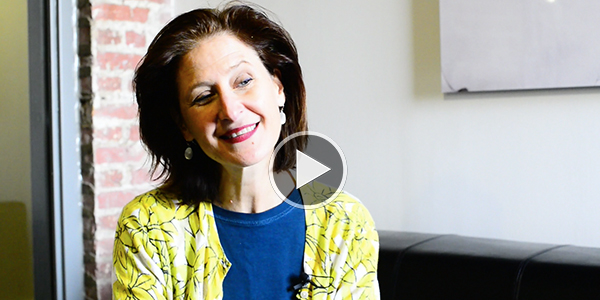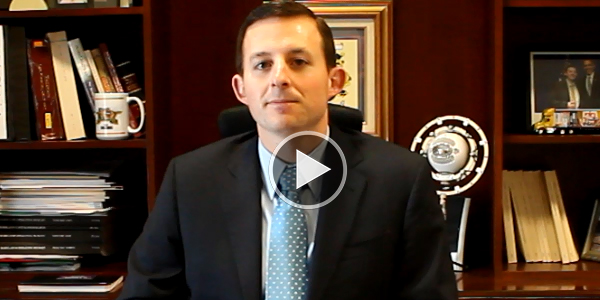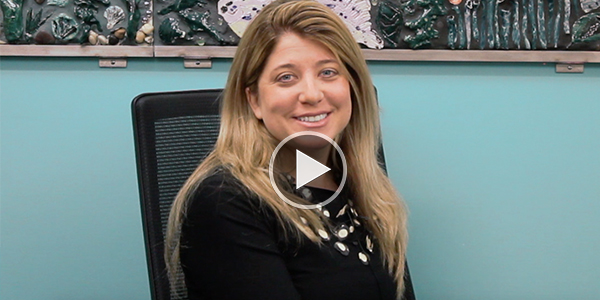Blog
Spreading hope through art
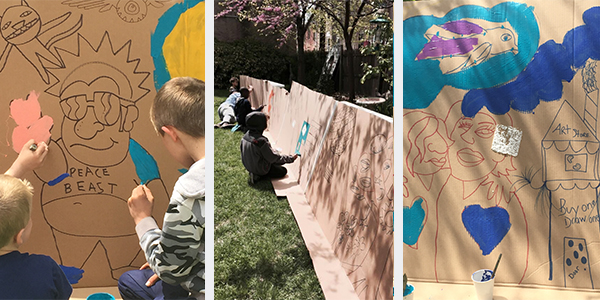
By Jessica Porter, Young Audiences Program Director
Tuesday morning in Baltimore began with a somber tone. As community members cleaned up our streets, led peaceful demonstrations, and opened their doors to their neighbors who needed a place to go, reflect, and process, something beautiful began to happen.
Early on in the day, I was struggling to find ways to productively volunteer. Despite our initial frustrations, the Young Audiences staff worked collaboratively with each other and with our artists to identify ways to positively affect the lives of quite a few people in meaningful, creative, and important ways throughout the day.
Young Audiences’ musician Kevin Martin volunteered to provide his Steel Drum Experience program, with children and volunteers who were spending the day at The 29th Street Community Center. Our very own Chief Innovation Officer Pat Cruz and several Young Audiences staff partnered with puppeteer Michael Lamason to get arts activities, such as mural painting, puppet making, and a free puppet show, off the ground at Black Cherry Puppet Theater.
This doesn’t even touch on the powerful work our artists were doing on their own! In a 10-minute span of the local news Tuesday evening, I saw at least four different artists I’ve worked with in some capacity during my time at Young Audiences right in the epicenter of the healing taking place in our city. Having long been active members of the communities in which they live, many of our artists are poised to lead the change that our city deserves.

When Kevin called me to say he was on his way to the 29th Street Community Center, I decided to come along. There were only about a dozen students at the center, and probably just as many volunteers, but seeing the smiles on those kids faces was the hope that I needed. I could tell the experience provided a much needed spark for the other adults too. The students chose to name our band “Monkey Kids.” Though we had only 40 minutes together, at the end we performed a rough rendition of the Toots and the Maytals’ song “Monkey Man”–and everyone walked away beaming.
Across town at Black Cherry Puppet Theater, more than 30 kids and parents gathered to draw, paint, and create their own puppets before a free puppet show mid-afternoon. This was a true community effort, as artists donated their time and volunteers contributed food and labor.
We’ve all got a lot of work to do in order to see the change our city needs, but I am more confident than ever in the transformational power of our work, and thanks to my experience, I am once again hopeful for our city’s future.

The positive side effects of the arts
By Donna Greenleaf, Coordinator of Gifted and Talented Programs, Dorchester County Public Schools, and Renee Hesson, Coordinator of Instruction for Fine Arts, Dorchester County Public Schools
Being on the Eastern Shore, Dorchester is relatively isolated from many of the cultural experiences available closer to the Baltimore-Washington area. With reduced opportunities to experience art, children and adults can become limited in their thinking and understanding of different art forms. Working with Young Audiences, we tried to find a way to make an arts learning program that was more lasting for Dorchester students. Last year, we developed an assembly and workshop model—something that was totally new to the schools in our county. In the past, we had only ever had large group assemblies. These performances felt like “one and done” experiences and it was hard to measure the impact of this limited exposure to the arts on our students. By adding workshop sessions, we were able to reach more students in a more significant way because they had a hands-on experience with Young Audiences performing ensembles WombWork Productions and Quest Visual Theatre.
This assembly and workshop model was successful, but we thought there was still more to be done to truly impact the culture and climate of our schools through the arts. Artist-in-residence programs have the feature of offering professional learning opportunities to teachers while providing ongoing workshop opportunities to students. Although this was the type of program we believed our schools needed for the arts to have the maximum impact, we told Young Audiences that there was no way that we would be able to afford it. But with Young Audiences’ help, we began applying for grant funding to help alleviate the cost and make it happen.
Beginning last spring, we wrote Maryland State Arts Council Arts in Education Artist-in-Residence Grants to bring programs to seven Dorchester elementary and middle schools of the 11 total schools in our district. To supplement this funding, we also applied for a grant from a local foundation, the George B. Todd Fund and for supportive funds from the local Dorchester Center for the Arts. We hoped to bring WombWork back to build on the work they did with our students the year before, as well as bring beatboxer Max Bent and Hip Hop poet Bomani to our students. These Young Audiences artists were chosen to address the specific needs each school had identified as a part of their school improvement plan, including interpersonal skills, bullying prevention, math, and language arts.
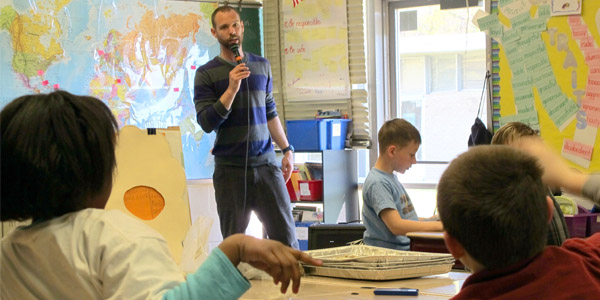
These programs were as much for the kids as they were for the teachers. When Max came to our elementary schools, his enthusiasm brought a lot of energy to the kids and appealed to those kids who needed a different kind of artistic outlet. His program crossed cultural stereotypes and appealed to a wide-range of kids—and adults. Our teachers were reluctant at first, but Max was able to bring everyone into the experience. During pre-program meetings with Max, teachers were impressed that he was able to speak their language. His art form became more than just a nice enrichment activity, but one that made a strong connection to curriculum. Max was interested in what specific units and standards the teachers were working on at the time, and how he could incorporate beatboxing. He wanted to do more than tie into grade-level concepts, but ensure that it was focused and timely in the curriculum. That approach enhanced the partnership feeling between artist and educators.
During the professional development workshops, Max showed teachers how beatboxing can uniquely link to fractions. It was a distinctive example of how educators have to challenge themselves to come up with new and unique ways to teach the material instead of the same ways they’ve always taught.
In another one of our schools, Mama Rashida and WombWork worked with one classroom that had a reputation for negative behavior and not staying on task when an outsider visited. When we visited this class to observe them working with Mama Rashida on the play they were creating to perform for their peers, every single student was engaged and working together on the activity. Mama Rashida’s knowledge of young people and how to quickly build relationships helped support our students emotionally so that the group could get to the important work of learning the language of virtues. This experience proved to us—and to the students—that they have the ability to be college- and career-ready middle school students. They now have a relationship with their classroom teacher that they may not have had without this program.
When Max’s residencies began, we thought kids may be reticent about getting up in front of their peers and performing. At both culminating events at the close of the residencies, there was an overwhelming show of hands of students who wanted to get up and demonstrate what they had learned. It was exciting to see our kids transform into performers and there was no judgment. Even when a child got up and made a mistake, other students didn’t call them out. They were supportive of each other. Seeing this program’s contribution to a positive school climate, as students worked together on projects and supported each other, was a wonderful side effect of our residencies this year.
Maryland State Arts Council (MSAC) provides schools with AiE grants to support artist-in-residence programs. These grants can subsidize up to 30 percent of the total cost of a Young Audiences residency program, including travel costs. The application deadline for programs occurring next school year is Friday, May 15, by 5 p.m. Read more about this opportunity at yamd.org.
Summarize math concepts with Hip Hop
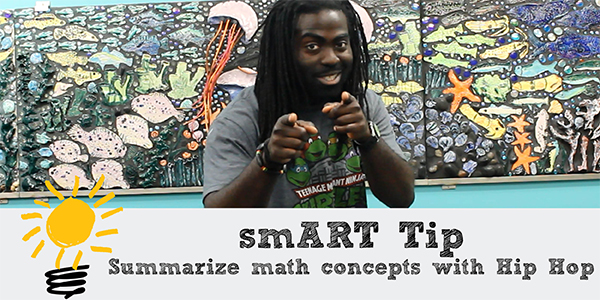
Rhyming couplets are a great way for students to summarize their knowledge and demonstrate their understanding of math concepts. In April’s smART Tip, Young Audiences Hip Hop musician Jamaal “Mr. Root” Collier shows teachers how to get started!
smART Tips is a monthly video series sharing tips for educators who are interested in new, creative ways to use the arts in their classroom with students. See all smART Tips to date here. Interested in a specific topic? Let us know!
Meet Our Artists: Quest Visual Theatre

Young Audiences’ roster of artists continues to grow to encompass new artists, ensembles, and art forms, from slam poets to improvisers to Capoeira masters.
We’ll be regularly posting interviews with our artists, giving them a chance to share more about themselves and their experiences bringing their Young Audiences programs to schools. We recently sat down with Tim McCarthy of Quest Visual Theatre.
Why did you decide to become a Young Audiences roster ensemble and how does it align with Quest Visual Theatre’s larger mission?
I had known several artists in Maryland who were with Young Audiences and I began to investigate what the organization was about. It made me think about where Quest Visual Theatre was heading and I thought it was something worth pursuing because we have so much experience working with children.
We are an inclusive company. Deaf people are a part of everything we do everyday and we wish to celebrate the people who are in this world. That’s the world we want to live in and we wish to bring those experiences it into children’s lives.
Quest also uses visual theatre to cut across language and cultural barriers. All of our work is inclusive and accessible. Everything that Quest does reflects the company’s commitment to welcoming to all people. One program that reflects that is QuestFest, which is a biennial international visual theatre festival. Quest partners with area theaters, universities, and agencies to present performances, conduct approximately 20 residencies, and provide training in visual theatre. The QuestFest Community Showcase enables students who have participated in QuestFest residencies to share work that they created.
What has been the most memorable part of the programs you have brought to the students with Young Audiences?
I love what I’m bringing into the schools and seeing how engaged the students are. Quest does little warm-ups before each performance. We play a game like charades with the audience. We have the audience begin to guess what the actors are doing; playing baseball, football, or golf. That really gets the kids involved and excited.
Do you have a memory of when you felt that you has an impact upon a student or class?
Students usually don’t know how to approach our actors because they are deaf, but after a performance or residency, we intentionally spend time and stick around to interact with the children. That’s when the hugs begin to happen. Things really change at that point. They see our artists as people they want to interact with. The communication barrier goes away.

How does your art form help connect students to what they are learning in school ?
Our goal is to integrate theatre into the curriculum. We do this by focusing upon two primary areas, including learning readiness and literacy.
How do the lessons that you teach students apply to and affect their everyday lives outside of the classroom?
In addition to learning the art form, the developmental skills we are focus on are communication and interpersonal skills. When you’re creating something and working in collaboration with others, especially if you’re not able to speak, you’re going to have to be clear about what your intentions are. Our lessons teach children how to send and receive information clearly with engagement.
Learn more about Quest Visual Theatre‘s offerings through Young Audiences.
Identifying P.R.I.D.E.

By Christina Delgado, Young Audiences photographer and visual artist
Digital photography is an art form that provides instant gratification. You can see your progress faster than you would with painting, drawing, or ceramics. Because of the age we live in, people are multimedia-driven and our society works efficiently with cell phones, computers, and the internet. I find that digital photography is yet another way technology has changed our approach to a task, and I believe it integrates well into education. Technology can give relevance to the art of photography, while also lowering a barrier. Easy-to-use digital cameras allow students to see themselves as artists and to express themselves creatively. This is something I wanted to teach my second- to fifth-grade students at Moravia Park Elementary when I began my residency with teacher partner and good friend, Cicely Jones, at the school in January.
I worked with students who were a part of the school’s P.R.I.D.E. program, which supports students with social and emotional learning differences. I started by giving students an overview of cameras and portrait photography. I wanted to teach them how to effectively take pictures and understand a photo’s ability to communicate feelings and ideas. Children aren’t always aware of how they are surrounded by photography every day. When they are looking at magazines or billboards, those are photographs! Getting them to understand how this art form is relevant to their everyday lives was important to their development throughout this residency.
The project I assigned students was based on a book of famous portraits that I found in a local bookstore. It showed all kinds of unique examples of portraiture, including Oprah, President Obama, and Billie Holiday. These pieces not only showed portraits of the individuals, but it also mapped out a collage of drawings, symbols, and words explaining what was important to each subject.

I had students build something similar so that they could share their own perspectives. Collaging items from magazines with their own photographs helped them define their sense of identity as they pieced the parts together. Their collages focused upon various aspects of their worlds, including interests, hobbies, and what makes them feel safe.
Some students really connected with each other through this project. One student, Trevor*, took the initiative to help another student who was having trouble focusing by sitting down with him, helping him cut out images, and discussing the project. Together, they were able to complete the work on the project for that day.
With Cicely and our faculty team, we came up with an idea that would give the students some independence. We provided disposable cameras to each of the students so that they could create images on their own time. This allowed the students to share a more well-rounded view of who they were. Giving them that responsibility really made a difference. Students felt important because they were expected to do something at a higher level–it was a very special moment.
Ultimately, the whole experience was wonderful and I appreciated the fact that Cicely brought me in to be a part of their team. During the final residency meeting, I got emotional after hearing what Cicely had to say about the improvement she had seen in her students during the residency. There were less behavioral issues and attendance was up. Hearing that positive change validated what I do. Sometimes it’s easy for artists to feel like the things they do go unseen, but this experience had an enormous impact upon the students I met. They were coming to school and they were staying positive and being productive. As children grow up, there are moments in their lives that they will never forget. I think these memories will go far.
Learn more about Christina’s photography residency programs for schools at yamd.org.
*Student names have been changed to protect their privacy.
Donor Spotlight: Chris Wallace
The arts were an integral and memorable part of Chris Wallace’s childhood. Her mother, Doris Morgan, an elementary school teacher and learning disabilities specialist, taught both her children and her students with joy, positivity, and an arts-integrative approach. This had a lifelong impact on them all: Chris made the arts a central component in her speech-language pathology work; her sister flourished as a writer; and former students or their parents would often approach Doris, thanking her for the impact she made on their lives and letting her know that they believed she was instrumental in their—or their children’s—success.
Several years ago, Chris was invited to attend Young Audiences’ annual Impact Breakfast, where she was impressed by the extent and impact of Young Audiences’ programs, students’ testimonials, and Executive Director Stacie Sanders Evans. In November 2013, Chris joined the Young Audiences board and, after her mother passed away in early 2014, she and her husband David made a generous, multi-year donation in Doris’ memory. The Doris Morgan Fund supports teaching artists participating in Young Audiences’ Maryland Wolf Trap Early Learning Through the Arts program, a 16-session residency that gives Pre-K students an in-depth experience with an artist as well as providing embedded professional development for teachers, making an impact that extends far beyond the life of the program.
At a recent site visit, Chris witnessed her first Wolf Trap residency in action, led by Young Audiences teaching artist and dancer Valerie Branch. On the day of Chris’ visit, the classroom teacher was leading her first arts-integrated lesson, developed after several sessions of collaboration with, and mentorship by, Valerie. Chris was impressed by what she saw, especially the embedded professional development that is an integral part of the Wolf Trap program.
Chris believes that the work that Young Audiences does with Maryland’s youngest learners is essential, and is happy that her mother’s legacy of bringing creativity into the classroom can live on with Young Audiences’ help. We are deeply grateful for the Wallaces’ generosity and are proud to honor Doris Morgan’s life by continuing to supply the resources needed to empower students and teachers in the classroom.
If you have a loved one whose memory you would like to honor, please consider making a donation to Young Audiences in their name, knowing your support will positively impact children’s lives through the arts.
Use simple circuitry in sculpture in March’s smART Tip
In March’s smART Tip, Young Audiences visual artists and STEAM experts FutureMakers show how students can use simple and affordable LEDs to make sculptures that light up! Press play to learn more:
[youtube https://youtu.be/TkNZsA-92SU]
smART Tips is a monthly video series sharing tips for educators who are interested in new, creative ways to use the arts in their classroom with students. See all smART Tips to date here. Interested in a specific topic? Let us know!
Why Do the Arts Matter? with Melani Douglass
[youtube https://youtu.be/4nrXYzjINZ0]
From a curator’s perspective, hear Melani Douglass, founder of The Family Arts Museum, share her #WhyArts response by focusing upon the importance of family as fine art, home as curated space, and community as gallery.
You can join us in celebrating #YAWeek by creating a video, taking a photo, writing a few words, or sharing a piece of artwork that tells a story of how the arts have impacted your life. Learn how to share your story and other ways you can get involved this week at yamd.org.
Continue checking in with the Young Audiences Blog, and follow us on Facebook and Twitter as we post more videos, news, and updates throughout #YAWeek.
Why Do the Arts Matter? with Lisa Mathews
[youtube https://youtu.be/ShmRroV0dso]
Lisa Mathews, a singer with Young Audiences ensemble Milkshake and a Maryland Wolf Trap teaching artist, joined our #WhyArts campaign by sharing her perspective on why the arts matter to her and to all Maryland children.
You can join us in celebrating #YAWeek by creating a video, taking a photo, writing a few words, or sharing a piece of artwork that tells a story of how the arts have impacted your life. Learn how to share your story and other ways you can get involved this week at yamd.org.
Continue checking in with the Young Audiences Blog, and follow us on Facebook and Twitter as we post more videos, news, and updates throughout #YAWeek.
Why Do the Arts Matter? with Senator Bill Ferguson
[youtube https://youtu.be/zWQg6tMzN7o]
We’re continuing our social media campaign asking community members “Why Do the Arts Matter?” to celebrate National Young Audiences Arts for Learning Week (YA Week). Maryland State Senator Bill Ferguson shared his perspective in a #WhyArts video.
You can join us in celebrating #YAWeek by creating a video, taking a photo, writing a few words, or sharing a piece of artwork that tells a story of how the arts have impacted your life. Learn how to share your story and other ways you can get involved this week at yamd.org.
Continue checking in with the Young Audiences Blog, and follow us on Facebook and Twitter as we post more videos, news, and updates throughout #YAWeek.
Why Do the Arts Matter? with Stacie Sanders Evans
[youtube https://youtu.be/2hte9mBOtrU]
During National Young Audiences Arts for Learning Week (YA Week) we’re leading a social media campaign to ask community members “Why Do the Arts Matter?” Young Audiences Executive Director Stacie Sanders Evans shared her perspective in a #WhyArts video.
Join us in celebrating #YAWeek by creating a video, taking a photo, writing a few words, or sharing a piece of artwork that tells a story of how the arts have impacted your life. Then nominate your friends, family, and colleagues to participate as well! Learn how to share your story and other ways you can get involved this week at yamd.org.
Check in with the Young Audiences Blog and follow us on Facebook and Twitter as we post more videos, news, and updates throughout #YAWeek.
Happy YA Week!
[youtube https://youtu.be/0VQlYtL4604]
National Young Audiences Arts for Learning Week (YA Week) is a time to celebrate the national YA network of affiliates and show support for arts-in-education! For 65 years, Young Audiences/Arts for Learning Maryland has worked to transform the lives and education of Maryland students through the arts. The national Young Audiences network of 30 affiliates was founded in Baltimore in 1950, and reached 5 million children last year alone. In Maryland, Young Audiences served nearly 170,000 students at 450 schools and community organizations throughout all 24 school districts during fiscal year 2013-2014.
Help us celebrate National YA Week here in Maryland by showing your support of Young Audiences and the power of the arts throughout YA Week. There are lots of ways you can get involved–join us!















